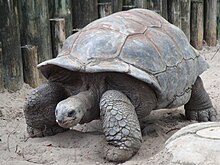Giant tortoise
| Giant tortoise | |
|---|---|
 |
|
| Aldabra giant tortoise | |
| Scientific classification | |
| Kingdom: | Animalia |
| Phylum: | Chordata |
| Class: | Sauropsida |
| Order: | Testudines |
| Suborder: | Cryptodira |
| Family: | Testudinidae |
| Genera | |
Giant tortoises are characteristic reptiles that are found on two groups of tropical islands: the Aldabra Atoll in Seychelles and the Galapagos Islands in Ecuador (a population at the Mascarene Islands was exterminated by the 1900s). These tortoises can weigh as much as 417 kg (919 lb) and can grow to be 1.3 m (4 ft 3 in) long. Giant tortoises originally made their way to islands from the mainland; for example, Aldabra Atoll and Mascarenes giant tortoises are related to Madagascar tortoises while Galapagos giant tortoises are related to Ecuador mainland tortoises. This phenomenon of excessive growth is known as islands gigantism or insular gigantism. It occurs when the size of the animals that are isolated on an islands increases dramatically in comparison to their mainland relatives. This is due to several factors such as relaxed predation pressure, competitive release, or as an adaptation to increased environmental fluctuations on islands. These animals belong to an ancient group of reptiles, appearing about 250 million years ago. By the Upper Cretaceous, 70 or 80 million years ago, some had already become gigantic. About 1 million years ago tortoises reached the Galápagos Islands. Most of the gigantic species began to disappear about 100,000 years ago. Only 250 years ago there were at least 20 species and subspecies in islands of the Indian Ocean and 14 or 15 subspecies in the Galápagos Islands.
Although often considered examples of island gigantism, prior to the arrival of Homo sapiens giant tortoises also occurred in non-island locales, as well as on a number of other, more accessible islands. During the , and mostly during the last 50,000 years, tortoises of the mainland of southern Asia (Colossochelys atlas), North and South America, Australia (Meiolania), Indonesia,Madagascar (Dipsochelys), and even the island of Malta became extinct. The giant tortoises formerly of Africa died out somewhat earlier, during the late Pliocene. While the timing of the disappearances of various extinct giant tortoise species seems to correlate with the arrival of humans, direct evidence for human involvement in these extinctions is usually lacking; however, such evidence has been obtained in the case of Meiolania damelipi in Vanuatu. One interesting relic is the shell of an extinct giant tortoise found in a submerged sinkhole in Florida with a wooden spear piercing it, carbon dated to 12,000 years ago. Today, only one of the species of the Indian Ocean survives in the wild, the Aldabra giant tortoise (two more are claimed to exist in captive or re-released populations, but some genetic studies have cast doubt on the validity of these as separate species) and 10 extant species in the Galápagos.
...
Wikipedia
